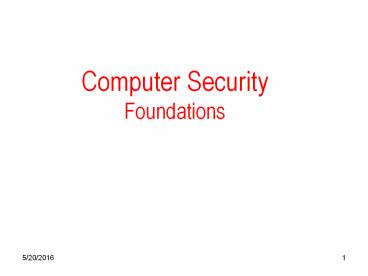Computer Security Foundations - PowerPoint PPT Presentation
Title:
Computer Security Foundations
Description:
In our model a computer system is represented by a family of ... Protection was in terms or rights and the ACM was the used to ... – PowerPoint PPT presentation
Number of Views:19
Avg rating:3.0/5.0
Title: Computer Security Foundations
1
Computer SecurityFoundations
2
Security
- How can one determine when a computer system is
- secure?
- What does secure mean?
3
Reminder
- In our model a computer system is represented by
a family of - states the set of all protection states P must
be a subset of the - set of authorized states Q if the system is to
be secure. - In the previous section we used a primitive, the
ACM, to manage - a protection system.
- Protection was in terms or rights and the ACM was
the used to - relate subjects to objects (also basic
primitives). - We also discussed protection state transitions
and commands, - which correspond to (cause) a sequence of state
transitions.
4
Security - definitions
- Let R be the set of (primitive) rights of the
system, r e R - and A be the ACM.
- If r e R is added to an element of A not already
containing r, then r is said to be leaked. - Let s0 be the initial protection state. If a
system can never leak r e R then the system is
safe wrt r.
5
Security safe vs secure
- We use the term safe to refer to the (abstract)
model. - Secure will be used when referring to
implementations. - So a secure implementations must be modeled on a
safe - system.
- Example safe vs secure --see textbook
6
Foundation theorems
- The model used is based on protection sates, the
ACM - and a set of commands essentially the HRU model
- (discussed in the previous section).
7
Theorem 1
- There exists an algorithm that will determine
whether a - given mono-operational protection system with
initial - protection state s0 is safe wrt a generic right.
- Proof see textbook.
- This whole section is a project topic for anybody
who is - interested in the foundations aspect of Computer
Sercurity.
8
Theorem 2
- It is undecidable whether a given state of a
given - protection system is safe wrt a generic right.
- Proof --reduction to the halting problem.
- The proof is by contradiction. It is shown that
an - arbitrary Touring Machine can be reduced to the
safety - problem with the final state corresponding to the
leaking - of a right.
- For details see textbook.
9
Theorem 3
- The set of unsafe systems is recursively
enumerable. - (accepted by a TM).
- So we can generate a list of all unsafe
protection - systems.
10
The Take-Grant protection model
- Can the safety of a protection system with
specific rules - be established?
- Answer the Take-Grant protection model.
- This model is represented by a directed graph.
Vertices - are subjects ? or objects ?, or both ?.
Edges are - labeled by a set of rights, that the source has
over the - destination. R contains two distinguished rights
t (take) - g (grant).
11
Transitions rewriting rules
- Take rule
- Grant rule
- Create rule
- Remove rule
- Details slides
12
Theorem 1
- Let G0 be a protection graph containing just one
subject vertex - and no edge and let R be a set of rights. Then
- G0 G iff G is a finite directed acyclic graph
with subjects - and objects only, with edges labeled for
non-empty subsets - of R and at least one subject (a trusted entity)
having no - incoming edge.
- Proof in textbook.
- Discussion in class.
13
Closing the Gap
- We can answer the safety question in specific
- systems, but not for generic systems (eg. the HRU
- system).
- What characteristics distinguishes a model for
which - the safety problem is decidable from one in which
it is - undecidable?
14
Closing the Gap
- The Schematic Protection Model (SPM)
- The Extended Schematic Protection Model (ESPM)
- Typed Access Matrix Models (TAMS)
15
The Schematic Protection Model (SPM)
- This model is based on the notion of a protection
type. - This is a label that determines how control
rights affect - an entity.
- Rights are partitioned into sets of
- Inert rights (RI) and
- Control rights (RC)
- Inert rights do not alter the protection state of
a system. - For example reading a file does not modify which
- entities have access to the document so is an
RI. - However in the Take-Grant model the take rule
does, so is in RC.
16
The Extended Schematic Protection Model (ESPM)
- Implicit in the SPM is the assumption of a single
parent. - ESPM allows for more parents. This problem arises
in - distributed systems.
- Example
- Anne and Bill must cooperate to perform a certain
task, - but do not trust each other.
- Such tasks may be achieved by using proxies each
- create a proxy, and grants the others proxy only
those - rights that are needed to perform the task.
17
Typed Access Matrix models (TAMS)
- The safety properties of SPM and ESPM are
implicitly - based on types. The TAM model is adds the notion
of - type explicitly.
- The type of an entity is fixed when the entity
is created. - A protection state of a system is defined as
- (S, O,t, A)
- where, S set of subjects , O set of objects,
A the - Acess Control Matrix, T the set of types and t
O ?T - For details see textbook.































